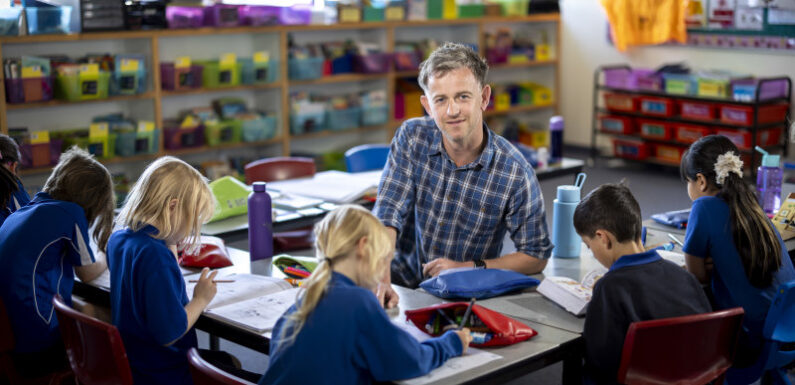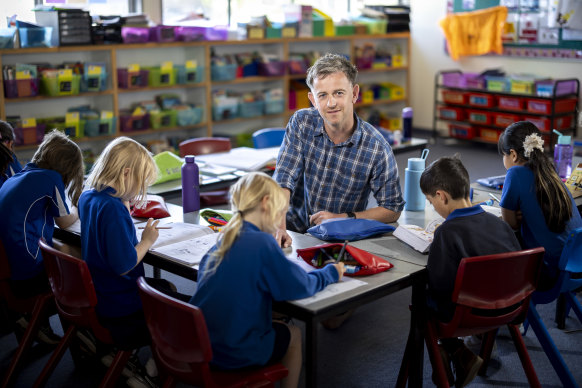
Save articles for later
Add articles to your saved list and come back to them any time.
Hundreds of classroom vacancies are going unfilled every week, lessons are being combined or cancelled and student report cards long delayed as a casual teacher shortage pushes already short-staffed schools to desperate measures.
Casual teachers have become highly sought after as recruitment agencies scramble to meet daily requests, allowing them to demand certain conditions.
Many casuals have signed up to a guaranteed five-day week, while others have requested to only work at primary schools within 15 minutes of home and still get their choice of jobs.
Casual teacher Andrew White: “You just have to act with your instinct and your experience and go with it.”Credit: Wayne Taylor
The reasons for the dearth of casuals are varied, with declining enrolments in teaching degrees, heavy workloads and lack of flexibility driving an exodus from the profession.
The crisis was exacerbated during COVID, when older teachers wary of getting sick took early retirements and closed borders cut the supply of international workers.
A scarcity of permanent teachers is feeding the problem, as those turning to relief work create more vacancies to be filled by casuals and schools offer enticements to lure relief teachers back to the workforce.
Unlike NSW where casuals are centralised, Victorian schools hire relief staff through 12 different temp agencies. Some also hire casuals directly. As a result, it is difficult to gauge how many shifts are going unfilled or even how many teachers are working as casuals.
Schools that can’t fill shifts make do in many ways, relying on permanent teachers to supervise combined classes – sometimes multiple classes in a school gym. In the longer term, programs and electives can also be rationalised.
Andrew White thought he would miss the connection with his students when he became a casual teacher two years ago. He found out that assumption was wrong.
“There’s just so much more to permanent teaching than what people think,” he said.
“You spend 75 per cent of your school time with the kids, but really, that’s only 25 per cent of your job load. Casual teaching gave me the space to be more present in my teaching with the kids.”
White works five days each week for temp agency anzuk.
When he arrives at a new school, White is given a rundown of where things are. If it’s a planned absence, teachers often leave behind learning resources.
It’s never happened to him, but White has heard of casuals starting the day with nothing.
“You just have to act with your instinct and your experience and go with it,” he said.
The casual teacher shortage extends across public, private and Catholic sectors. At its peak in winter, there were hundreds of vacancies going unfilled each day.
Casuals can make $410 a day working at metropolitan schools, with additional loading in regional areas. They are not expected to write reports or lesson plans, or participate in extracurricular activities.
Daniel Mundy, anzuk’s founder, said the agency was working to recruit more teachers overseas, but the government needed to increase its focus on vocational training to get students into classrooms more quickly.
Cranbourne East Secondary College has almost 2000 students and 140 full-time teachers. On an average day, the school in Melbourne’s high-growth south-east corridor needs nine casual teachers just to manage staff absences and off-campus activities. In winter, the casual roster peaked at 19.
Principal Meagan Cook has worked hard to anticipate vacancies, recruiting from both agencies and the local area, but still has to contend with last-minute cancellations around holidays and long weekends.
This stretches her permanent staff, leading to sickness and, ironically, more demand for casuals.
“It’s been hard work,” she said. “Recruitment is constant.”
The Education Department said it had grown the teaching workforce by 8000 – twice the national average – since 2020. There are a range of initiatives to ease the shortage, including free degrees for secondary teachers, a trial of new employment-based teaching programs for undergraduate students and money to attract teachers to hard-to-staff roles in rural and regional schools.
Cook said none of the programs were an immediate fix.
“And what we do as principals is we keep plugging the gaps and making sure things run smoothly at our end, to do the best we can for every kid in our school every day,” she said.
Parents Victoria chief executive officer Gail McHardy said workforce shortages were playing havoc in some school communities but schools were required to report on students twice a year.
“Both schools and families will be fatigued and frustrated but we urge everyone to have patience and understanding.”
Victorian Association of State Secondary Principals president Colin Axup said the casual deficit and overall teacher shortage were “two sides of the same coin”, which in turn contributed to the growing problems of disruption in classrooms and school refusal.
Axup said while it was difficult to gauge the extent of the crisis, it would be fair to assume Victoria’s shortage was of a similar scale to the crisis in NSW, where the teachers’ union last month reported a shortage of 3000 casuals per day.
In addition to casual shifts going unfilled, Axup said it was impossible to know how many principals simply combined classes instead of asking for relief teachers, or cancelled subjects because they could no longer staff them.
“The holes are everywhere,” he said. “We have metropolitan schools that are struggling to get staff. Over 10 years ago … there was already an issue about getting quality staff into rural and regional Victoria. The frustration is this should not have been a surprise.”
The Morning Edition newsletter is our guide to the day’s most important and interesting stories, analysis and insights. Sign up here.
Most Viewed in National
From our partners
Source: Read Full Article
